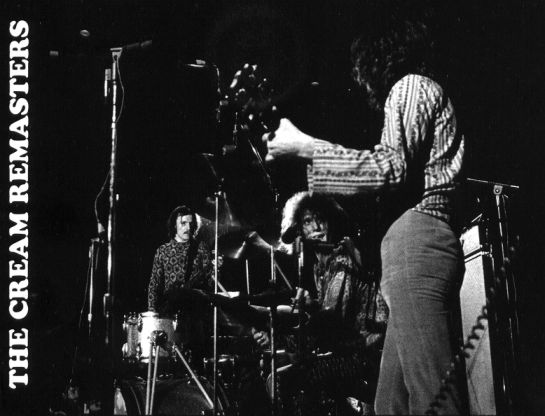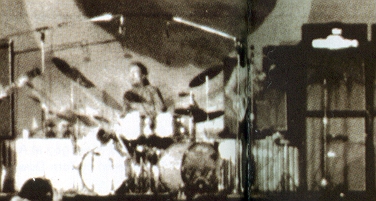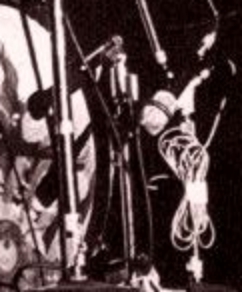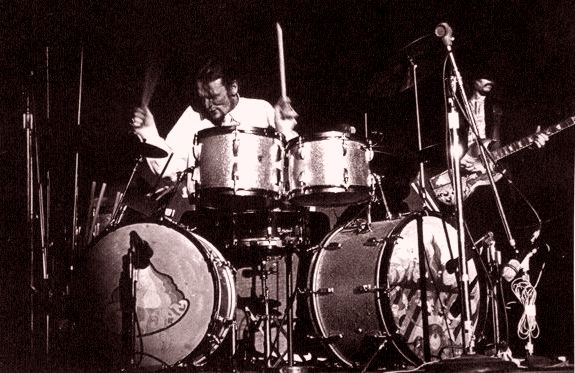

The Live Remasters: A Sonic Reappraisal
The ConcertsIn February 1968 Cream played a few warm up concerts before beginning their residency of 3rd -10th March in San Francisco. They were going to record live for their next album. Relations between the three were volatile. As a result performances were becoming increasingly variable but still with the highest level of musicianship.
Cream was to be recorded at the Fillmore Theatre and Winterland. Winterland was an ice rink converted to a concert venue by covering the ice with sheets of plywood. Bill Graham now used this as his main venue as it could hold over 5,000 people. He continued to use the Fillmore for those nights when the Winterland was not available and for Cream this was the 3rd & 7th of March.
The Recordings
Tom Dowd, with young engineer Bill Halverson, set up two 8 track recorders in the back of a truck to ensure they would capture the long jams as 1" tape at 30ips was limited to 20 minutes. They used a mixture of close miking on the stacks and distance overhead miking on the drums and distant on the bass (about 12"). This was the very early days of live recording of Rock music and these guys were literally doing it by ear. They used a jazz approach to the recording which was not appropriate for this high volume environment.
Tom Dowd had found it difficult to record Cream’s Marshall stacks and Baker's power drum sound in the studio . Now he had to record them at concert volume levels. Cream were one of the first super loud Rock bands so leakage (sound from the guitars bleeding into the drum mikes and even into each other’s mikes) was enormous. As a result he made Jack and Eric drop back to single stacks, as they had in the studio. This had two impacts: the drums were higher in the live balance and Eric lost his massive sustain. To partially compensate he played close to the stacks (see photo above) but it was one of those threshold effects – with two stacks the sustain happened wherever he stood and that normally was well away from them. That loss is particularly in evidence on "Stepping Out" and the absence of his thick woman tone throughout (compare it to the Grande Ballroom where it is a matter of damping the sustain rather then struggling to get it).
 Fillmore: Very distant, studio style, overhead drum mikes (they were lowered at the later Winterland sessions), mike stand against guitar stack |
The "Live at the Fillmore" disc of "Wheels of Fire" only has "Toad" recorded at this venue on the 7th March. The version from this concert was probably preferred for sound quality. It was a smaller venue with a tighter reverberation and less leakage as the drums were not heavily reinforced through the PA – they definitely were at the much larger Winterland. "Rollin’ & Tumblin’" is the only other release from this concert and it has a VERY different balance and mix. March 8 at Winterland has only provided "Traintime" and the "Toad" insert on "Those Were the Days" boxed set. Winterland of March 9 has provided more material: the much bootlegged "NSU" alternate on the boxed set, "Sunshine of Your Love", "Sleepy Time Time" and "Stepping Out". |
By the time of the Winterland recordings of the 10th both Cream and the engineers had got it together. It provided the bulk (and BEST) of the official live releases.
| From these Felix prepared a rough mono mix reference tape which was
used to select the best recordings/preferred performances. These rough mixes have been a
source of some bootleg releases. The final mix was to two track half inch from which the remasters are derived – the original multitracks were lost in the 1975 archive fire. Sorry there is no more except for the alternate "Toad" and possibly "We’re Going Wrong", on reference tape at least. |
 Winterland Bass Drum Miking: Close for PA reinforcement, studio style distant on boomstand plus a third which looks like a spare by the way the cable is tied up. |
The Remasters
The advent of CD’s saw the record companies simply reissuing records on the new medium. Rarely did they bother to take full advantage of the digital environment. The 2nd half of the ‘90’s has seen a glut of remasters as the companies returned to the original multi-track recording tapes and us fans obediently repurchased another copy.
If modern digital remastering is done correctly then the original mix should be retained but with increased clarity especially in the low bass and upper highs. Records do sound different to CDs because vinyl record’s required heavy frequency equalisation and volume compression. CD’s require no equalisation and only minimal compression. Using the master recording allows the music to be heard at maximum clarity.
In 1997 Polydor reissued the remastered Cream on a 4 CD set. Unfortunately on the Live recordings, Bill Levenson did not stick to Felix’s original mixes for a variety of reasons (my speculation):
The master recordings varied in mixing balance onto the two track
The Final Tour recordings were 4 track and thus impossible to unscramble
Most of the master recordings have been lost.
A desire to make Cream more acceptable by giving a modern mix of bass high and guitar back
Reduce tape noise as these were pre-Dolby
The most troublesome tracks were those from the October Oakland and L.A. concerts with there 4 track recording instrument mix. In a typical jazz approach, which was totally inappropriate, they put the left bass drum in with the guitar and hihat/snare with the bass. This produced the "Goodbye Cream" release with the bass in the right channel to get an acceptable stereo mix. It’s reasonable to speculate that this was a result of Ginger demanding a better drum mix then that achieved on "Live at the Fillmore". This was adjusted on the remasters but those recordings will always remain a mixing mess.
Felix had mixed a few alternate tracks for final selection: "Toad" from the 8th, "NSU" from the 9th, at least. These supplied the alternate "NSU’ and the instrumental insert on "Toad" on the boxed set. That "NSU" has a very similar mix to the 1st release remaster. "Toad" doesn’t as it sounds like they had a slightly different recording track allocation plus different hall reverb and closer miking. The remaster starts with the 7th recording and then changes to the 8th at the group instrumental break then back to the 7th for the original group jam and into the solo producing in a double length group instumental – the change is subtle but obvious when listening to the computerised digital copy. "Rollin’ & Tumblin’ " is also a very different mix, from the 7th again, and "Sleepy Time Time" from the 9th which were probably early mixes by Felix.
Unfortunately Felix’s producer involvement, despite the credit, didn’t extend to Live Cream Vol II. That was a typical crass release by the record company. The original remix engineers for that album didn’t have a clue as to Cream’s real live sound though the material they were left with was pretty poor sonically and musically. Trying to make a sonically coherent album (forget the music!) out of the Final tour tapes and the leftovers from March was basically impossible.
Enough said about October but of the March recordings: "Sunshine" has a mixed back guitar which was accurate as Eric played quieter to hear the vocals – Jack could hear himself (training) but Eric was a novice by ear singer. On the remasters the drums are cleaner and mixed higher which really makes it sound a lot better with Ginger driving it on. "Stepping Out" is weird: the guitar has high levels of hall reverb at odds to all the other tracks from these sessions. It is also officially credited to the 10th, which it clearly wrong based on the verified audience bootleg of that night. There are some mike masking effects (body moving between the mike and the speakers) so the only conclusion is that it is mixed from Eric’s vocals mike track (the recording and PA mikes were straped together on the one stand). I now believe this is from the 9th as the "Sleepy" outro and "Stepping" intro seem to be identical, comparing the original releases. Jeff Aarons finds a great similarity between this performance and the bootleg so consecutive nights is the best explanation.
Levinson also equalised the recordings with a significant treble cut (from 5khz) to reduce tape noise. The effect is reduced attack on the guitar and significantly reduced presence of the cymbals – "…hits the cymbals hard, very hard." In fact one of the standout things of many bootlegs is the big crashes of the cymbals even over the din of the stacks, specially that riveted monster (compare it to the drums on Pink Floyd’s beautifully remastered live CD on Ummagumma). The guitar was also further mixed back in the remastering by boosting the left to produce a modern mix of prominent bass.

Note: the mike on the snare between the bass drums, boom recording mike
stands, EC well back close to the stack
Conclusion
Well I love the clarity of the remasters but the mix leaves a lot to be desired. As magnificent as they sound it does not represent their real live sound where the guitar is much more prominent with loads of sustain from the dual stacks. The bass is also cleaner as Jack doesn’t get his dual stack distortion/feedback. Baker’s drums benefit, except for the cymbals, from the clarity but are not correctly balanced against the guitar.
The real downside is that the use of single stacks effected Eric’s playing. The loss of that massive sustain meant missed notes as he was subconsciously expecting notes to sustain for several beats instead of rapidly decaying. The drastic effect on "Stepping Out" and "Sunshine of Your Love", in comparison to the bootlegs, is manifest. Also his ‘woman tone’ was severely degraded. Yet, despite all this, with "Crossroads" he still managed to produce a guitar masterpiece.
© Graeme Pattingale, 2000.